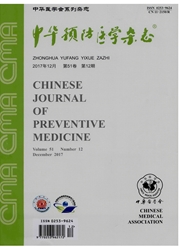

 中文摘要:
中文摘要:
目的利用以核心家系为基础的关联研究探讨细胞色素P450酶系(cytochrome P450,CYP450)CYP1A1基因m1和m2多态性并分析其与鼻咽癌易感性的关联。方法收集457个广东鼻咽癌核心家系(每个核心家系由患者和父母或同胞构成)共2134名成员作为研究对象,采用聚合酶链反应·限制性片段长度多态性(PCR—RFLP)方法对CYP1A1基因单核苷酸多态性(SNP)位点m1和m2(其参考编号分别为rs4646903和rs1048943)进行基因分型。挑选PCR产物测序验证。运用家系为基础的相关性检验(family—based associationtest,FBAT)软件分析这两个多态位点的基因型及其单体型与鼻咽癌易感性的关联。结果FBAT软件分析结果显示,位点m1和m2的微效等位基因频率(MAF)分别为0.442(C)和0.339(G)。其中无论是否根据EB病毒壳抗原抗体(VCA—IgA)分层,m1位点与鼻咽癌的易感性之间关联均无统计学意义[未分层:χ^2=2.399,P=0.301;分层后:低滴度组(VCA-IgA〈1:80),MAF=0.457(C),χ^2=1.221,P=0.543;高滴度组(VCA-IgA≥1:80),MAF=0.427(C),χ^2=2.832,P=0.243];对m2位点来说,未根据VCA—IgA分层时,该位点与鼻咽癌的易感性之间关联无统计学意义(χ^2=2.694,P=0.260)。分层后,在低滴度组,累加和显性模式下,位点m2等位基因G显示了从亲代到子代传递减少[MAF=0.347(G);Z累加=-2.120,P累加=0.034;Z显性=2.303,P显性=0.021],全局统计也提示了传递的改变(χ^2=5.394,P:0.067);由这两个位点构建的单体型TG(0.057)可能降低鼻咽癌的发病风险(Z=-2.002,P=0.045),全局统计也提示CYP1A1基因单体型可能与鼻咽癌易感性有关系(χ^2=7.067,P=0.070)。结论以家系为基础的相关性研究发现CYP1A1基因多态位点m1与鼻咽癌的易感性之间关联无统计学意义,位点m2基因多态?
 英文摘要:
英文摘要:
Objective To investigate the association between CYP1A1 gene polymorphisms and susceptibility of nasopharyngeal carcinoma in Cantonese nuclear families through family-based association study. Methods A total of 457 Cantonese nuclear families, consisting of 2134 members, were recruited as subjects. Each family included two parents and at least one offspring with nasopharyngeal carcinoma.Two single nucleotide polymorphisms (SNP) in CYP1A1 named ml ( rs4646903 ) and m2 ( rs1048943 ) , were genotyped by PCR-RFLP assay and verified by directly sequencing. The genotype data were analyzed with family-based association test (FBAT) software to check the linkage and association between the two genetic markers and susceptibility of nasopharyngeal carcinoma. Results FBAT analysis showed that the minor allele frequencies (MAF) of the two SNP were 0. 442 ( C ) and 0. 339 (G) respectively. For ml polymorphism in CYP1A1 gene was not significantly associated with nasopbaryngeal carcinoma in our study population whether stratified with VCA-IgA or not ( without stratification : χ^2= 2. 399, P = 0. 301 ; with stratification : lowtiter group ( VCA-IgA 〈 1 : 80 ), MAF = 0. 457 ( C ), χ^2 = 1. 221, P = 0. 543 ; high-titer group ( VCA-IgA I〉 1 : 80), MAF = 0. 427 ( C ),χ^2= 2. 832, P = 0. 243 ). For m2 polymorphism, when VCA-IgA 〈 1 : 80, the G allele showed decreased transmission under additive and dominant model ( MAF = 0. 347 (G) ; Zadditive = -2. 120,Padditive =0. 034;Zdominant= -2. 303 ,Pdominant = 0. 021 )and a boundary P value was got with global statistic (χ^2 = 5. 394, P = 0. 067 ) . Haplotype TG ( 0. 057 ), constructed by ml and m2, might decrease nasophargneal carcinoma risk (Z = -2. 002,P =0. 045). A boundary P value was also got with global statistic (χ^2 = 7. 067 ,P =0. 070 ). Conclusion There was no statistical significance between ml polymorphism and susceptibility of nasopharyngeal carcinoma in Cantonese nuclear families. And th
 同期刊论文项目
同期刊论文项目
 同项目期刊论文
同项目期刊论文
 Antibodies against Epstein-Barr virus gp78 antigen: a novel marker for serological diagnosis of naso
Antibodies against Epstein-Barr virus gp78 antigen: a novel marker for serological diagnosis of naso Clinical values of multiple Epstein-Barr virus (EBV) serological biomarkers detected by xMAP technol
Clinical values of multiple Epstein-Barr virus (EBV) serological biomarkers detected by xMAP technol Evaluation of a multianalyte profiling assay and an enzyme-linked immunosorbent assay for serologica
Evaluation of a multianalyte profiling assay and an enzyme-linked immunosorbent assay for serologica 期刊信息
期刊信息
